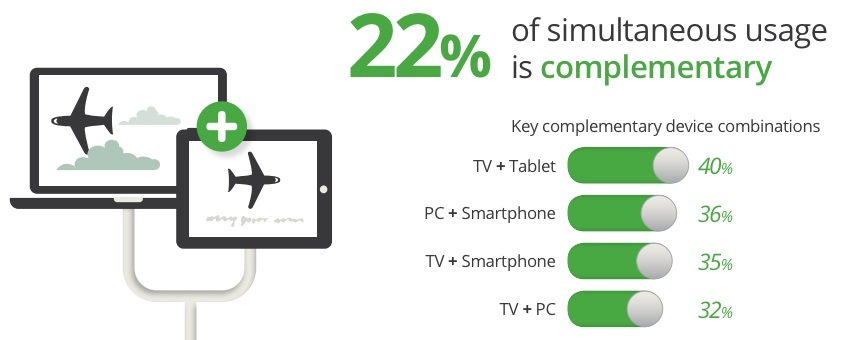Consumers like to multi-screen.
That’s according to a new report from Google, which not only turns “multi-screen” into a verb, it sheds some interesting light on consumer behaviors across multiple devices. In “The New Multi-screen World,” Google takes a 24-hour snapshot of the interplay between consumers - or multi-screeners - and their media engagement and multitasking habits across smartphones, tablets, PCs/laptops and TVs.
While the report covers everything from media usage in daily life, motivations for engaging with media, and the role search plays, it makes some particularly compelling points around the use of mobile with other screens and the impact that activities on one screen have on another. Specifically, Google identifies two primary modes of multi-screening: sequential usage and simultaneous usage.
Sequential users move among different devices at different times to accomplish a task. This could be something like searching for a TV listing on a tablet and later watching the show on your television set; or perhaps checking for flights on a smartphone and then booking tickets using a PC.

Complementary device usage sets the stage for synchronized dual-screen experiences.
Simultaneous users, meanwhile, use multiple devices at once for either unrelated or related activities. Unrelated activities could be something as simple as checking Facebook on your smartphone while watching TV, or browsing the Web during a television commercial break. Related activities might include using your smartphone to look up an actor who’s in a television program you’re watching, or using a tablet to get more information about an ad you just saw.
Google makes some good points about content on one device triggering behavior on another, saving progress between devices, and tailoring marketing strategies to each channel. They also stress that another screen is being used most of the time that TV is being watched, and suggest TV marketing strategies should line up closely and integrate with digital device strategies.
The integration of strategies is an interesting concept on its own, but why not extend it even further by actually synchronizing experiences between the TV and personal device? Rather than have a viewer search for that actor in the show they’re watching, what if the full cast list and bios along with other complementary information was already waiting at their fingertips on their iPhone? Or imagine if deeper, more immersive information about an advertised product was already waiting on the viewer’s iPad just as the ad aired on TV?
We feel these types of dual screen experiences have the potential to finally make TV truly interactive and really change how we think about creating content, be it programming, advertising, or even combinations thereof. Kind of how 3D is causing many filmmakers to take new approaches to movie making, the addition of a complementary second screen introduces entirely new dynamics to TV, in terms of how it’s made, consumed and monetized.
To foster the creation of these types of experiences, we introduced the App Cloud Dual-Screen Solution for Apple TV back in June. Part of our App Cloud mobile app platform, media publishers can use it to develop rich content apps for the iPhone and iPad that simultaneously control content, data, and information presented on an HDTV alongside synchronized content displayed on an iPad or iPhone. Our CEO, Jeremy Allaire, put together a quick video that takes viewers through a couple of samples, which you can watch below.
We’re really just beginning to grasp the staggering potential of what dual-screen could hold, and we have a long runway ahead of us. It’s fascinating time as the worlds of media, entertainment and technology continue to converge in so many new and different ways, and we at Brightcove are genuinely excited to be right in the middle.

